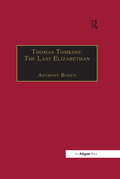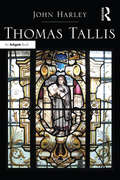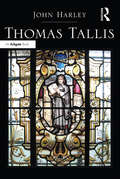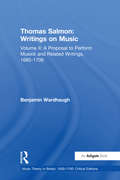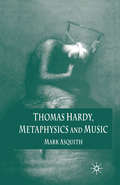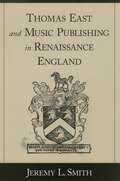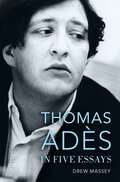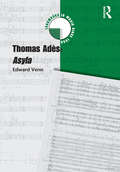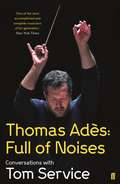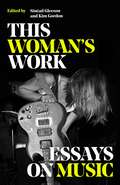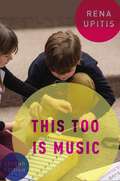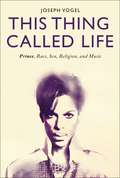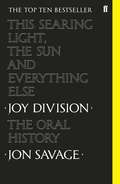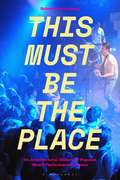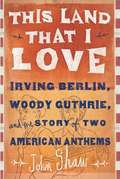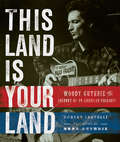- Table View
- List View
Thomas Tomkins: The Last Elizabethan
by Anthony BodenThomas Tomkins (1572-1656), a major figure of the Golden Age of British music, was arguably the greatest of all Welsh-born composers. Living through one of the most revolutionary periods in British history, his professional life was spent in the service of the Crown and the Church at both the Chapel Royal and Worcester Cathedral. Surviving the Civil War, the suppression of the music of the English Church, the closure of the Chapel Royal, the destruction of his organ at Worcester and the devastation of the city, Tomkins was able to find the strength and inspiration to continue composing secular music of fine quality. Much of Tomkins's output has survived, including his collection of music for the Anglican rite, Musica Deo Sacra, published posthumously in 1668. His work embraced both sacred and secular vocal music, pieces for keyboard and for viol consort, thereby proving him to be one of the most versatile figures of English Renaissance music. The first part of the book provides an absorbing biography of Tomkins, setting his life into fascinating historical context. The second and third parts include major essays on Tomkins by Denis Stevens, Bernard Rose, Peter James and David Evans, all authorities on the music of the period with each providing perceptive insights into Tomkins's music. The result is a successful piece of collective work that properly places Tomkins and his achievements in his time and enables readers to reassess him properly in relation to his elders and contemporaries. Tomkins has still not reached the 'household name' status of his great teacher, William Byrd, or of his close friend and colleague, Orlando Gibbons, but he is undoubtedly worthy of much greater recognition. The book complements the increasing number of live performances and recordings of Tomkins's music, both sacred and secular, and such a comprehensive account of the man and his work should appeal to early music scholars, performers and music lovers alike.
Thomas Tomkins: The Last Elizabethan
by Anthony Boden Denis Stevens Bernard Rose Peter James David R.A. EvansThomas Tomkins (1572-1656), a major figure of the Golden Age of British music, was arguably the greatest of all Welsh-born composers. Living through one of the most revolutionary periods in British history, his professional life was spent in the service of the Crown and the Church at both the Chapel Royal and Worcester Cathedral. Surviving the Civil War, the suppression of the music of the English Church, the closure of the Chapel Royal, the destruction of his organ at Worcester and the devastation of the city, Tomkins was able to find the strength and inspiration to continue composing secular music of fine quality. Much of Tomkins's output has survived, including his collection of music for the Anglican rite, Musica Deo Sacra, published posthumously in 1668. His work embraced both sacred and secular vocal music, pieces for keyboard and for viol consort, thereby proving him to be one of the most versatile figures of English Renaissance music. The first part of the book provides an absorbing biography of Tomkins, setting his life into fascinating historical context. The second and third parts include major essays on Tomkins by Denis Stevens, Bernard Rose, Peter James and David Evans, all authorities on the music of the period with each providing perceptive insights into Tomkins's music. The result is a successful piece of collective work that properly places Tomkins and his achievements in his time and enables readers to reassess him properly in relation to his elders and contemporaries. Tomkins has still not reached the 'household name' status of his great teacher, William Byrd, or of his close friend and colleague, Orlando Gibbons, but he is undoubtedly worthy of much greater recognition. The book complements the increasing number of live performances and recordings of Tomkins's music, both sacred and secular, and such a comprehensive account of the man and his work should appeal to early music scholars, performers and music lovers alike.
Thomas Tallis: His Life And Music
by John HarleyJohn Harley’s Thomas Tallis is the first full-length book to deal comprehensively with the composer’s life and works. Tallis entered the Chapel Royal in the middle of a long life, and remained there for over 40 years. During a colourful period of English history he famously served King Henry VIII and the three of Henry’s children who followed him to the throne. His importance for English music during the second half of the sixteenth century is equalled only by that of his pupil, colleague and friend William Byrd. In a series of chronological chapters, Harley describes Tallis’s career before and after he entered the Chapel. The fully considered biography is placed in the context of larger political and cultural changes of the period. Each monarch’s reign is treated with an examination of the ways in which Tallis met its particular musical needs. Consideration is given to all of Tallis’s surviving compositions, including those probably intended for patrons and amateurs beyond the court, and attention is paid to the context within which they were written. Tallis emerges as a composer whose music displays his special ability in setting words and creating ingenious musical patterns. A table places most of Tallis’s compositions in a broad chronological order.
Thomas Tallis: His Life And Music
by John HarleyJohn Harley’s Thomas Tallis is the first full-length book to deal comprehensively with the composer’s life and works. Tallis entered the Chapel Royal in the middle of a long life, and remained there for over 40 years. During a colourful period of English history he famously served King Henry VIII and the three of Henry’s children who followed him to the throne. His importance for English music during the second half of the sixteenth century is equalled only by that of his pupil, colleague and friend William Byrd. In a series of chronological chapters, Harley describes Tallis’s career before and after he entered the Chapel. The fully considered biography is placed in the context of larger political and cultural changes of the period. Each monarch’s reign is treated with an examination of the ways in which Tallis met its particular musical needs. Consideration is given to all of Tallis’s surviving compositions, including those probably intended for patrons and amateurs beyond the court, and attention is paid to the context within which they were written. Tallis emerges as a composer whose music displays his special ability in setting words and creating ingenious musical patterns. A table places most of Tallis’s compositions in a broad chronological order.
Thomas Tallis
by John HarleyJohn Harley’s Thomas Tallis is the first full-length book to deal comprehensively with the composer’s life and works. Tallis entered the Chapel Royal in the middle of a long life, and remained there for over 40 years. During a colourful period of English history he famously served King Henry VIII and the three of Henry’s children who followed him to the throne. His importance for English music during the second half of the sixteenth century is equalled only by that of his pupil, colleague and friend William Byrd. In a series of chronological chapters, Harley describes Tallis’s career before and after he entered the Chapel. The fully considered biography is placed in the context of larger political and cultural changes of the period. Each monarch’s reign is treated with an examination of the ways in which Tallis met its particular musical needs. Consideration is given to all of Tallis’s surviving compositions, including those probably intended for patrons and amateurs beyond the court, and attention is paid to the context within which they were written. Tallis emerges as a composer whose music displays his special ability in setting words and creating ingenious musical patterns. A table places most of Tallis’s compositions in a broad chronological order.
Thomas Tallis: His Life And Music
by John HarleyJohn Harley’s Thomas Tallis is the first full-length book to deal comprehensively with the composer’s life and works. Tallis entered the Chapel Royal in the middle of a long life, and remained there for over 40 years. During a colourful period of English history he famously served King Henry VIII and the three of Henry’s children who followed him to the throne. His importance for English music during the second half of the sixteenth century is equalled only by that of his pupil, colleague and friend William Byrd. In a series of chronological chapters, Harley describes Tallis’s career before and after he entered the Chapel. The fully considered biography is placed in the context of larger political and cultural changes of the period. Each monarch’s reign is treated with an examination of the ways in which Tallis met its particular musical needs. Consideration is given to all of Tallis’s surviving compositions, including those probably intended for patrons and amateurs beyond the court, and attention is paid to the context within which they were written. Tallis emerges as a composer whose music displays his special ability in setting words and creating ingenious musical patterns. A table places most of Tallis’s compositions in a broad chronological order.
Thomas Salmon: Volume II: A Proposal to Perform Musick and Related Writings, 1685-1706
by Benjamin WardhaughThis is the second volume in a two-part set on the writings of Thomas Salmon. Salmon (1647-1706) is remembered today for the fury with which Matthew Locke greeted his first foray into musical writing, the Essay to the Advancement of Musick (1672), and the near-farcical level to which the subsequent pamphlet dispute quickly descended. Salmon proposed a radical reform of musical notation, involving a new set of clefs which he claimed, and Locke denied, would make learning and performing music much easier (these writings are the subject of Volume I). Later in his life Salmon devoted his attention to an exploration of the possible reform of musical pitch. He made or renewed contact with instrument-makers and performers in London, with the mathematician John Wallis, with Isaac Newton and with the Royal Society of London through its Secretary Hans Sloane. A series of manuscript treatises and a published Proposal to Perform Musick, in Perfect and Mathematical Proportions (1688) paved the way for an appearance by Salmon at the Royal Society in 1705, when he provided a demonstration performance by professional musicians using instruments specially modified to his designs. This created an explicit overlap between the spaces of musical performance and of experimental performance, as well as raising questions about the meaning and the source of musical knowledge similar to those raised in his work on notation. Benjamin Wardhaugh presents the first published scholarly edition of Salmon's writings on pitch, previously only available mostly in manuscript.
Thomas Salmon: Volume II: A Proposal to Perform Musick and Related Writings, 1685-1706
by Benjamin WardhaughThis is the second volume in a two-part set on the writings of Thomas Salmon. Salmon (1647-1706) is remembered today for the fury with which Matthew Locke greeted his first foray into musical writing, the Essay to the Advancement of Musick (1672), and the near-farcical level to which the subsequent pamphlet dispute quickly descended. Salmon proposed a radical reform of musical notation, involving a new set of clefs which he claimed, and Locke denied, would make learning and performing music much easier (these writings are the subject of Volume I). Later in his life Salmon devoted his attention to an exploration of the possible reform of musical pitch. He made or renewed contact with instrument-makers and performers in London, with the mathematician John Wallis, with Isaac Newton and with the Royal Society of London through its Secretary Hans Sloane. A series of manuscript treatises and a published Proposal to Perform Musick, in Perfect and Mathematical Proportions (1688) paved the way for an appearance by Salmon at the Royal Society in 1705, when he provided a demonstration performance by professional musicians using instruments specially modified to his designs. This created an explicit overlap between the spaces of musical performance and of experimental performance, as well as raising questions about the meaning and the source of musical knowledge similar to those raised in his work on notation. Benjamin Wardhaugh presents the first published scholarly edition of Salmon's writings on pitch, previously only available mostly in manuscript.
Thomas Hardy, Metaphysics and Music
by Mark AsquithThis fascinating new study by Mark Asquith offers an original approach to Hardy's art as a novelist and entirely new readings of certain musical scenes in Hardy's works. Asquith utilizes a rich seam of original archival research (both scientific and musicological), which will be of use to all Hardy scholars, and discusses a range of Hardy's major works in relation to musical metaphors - from early fiction The Poor Man and the Lady to later major works Jude the Obscure, Far From the Madding Crowd, the Mayor of Casterbridge .
Thomas East and Music Publishing in Renaissance England
by Jeremy L. SmithIn the London of Shakespeare and William Byrd, Thomas East was the premier, often exclusive, printer of music. As he tells the story of this influential figure in early English music publishing, Jeremy Smith also offers a vivid overall portrait of a bustling and competitive industry, in which composers, patrons, publishers, and tradesmen sparred for creative control and financial success. It provides a truly comprehensive study of music publishing and a new way of understanding the place of musical culture in Elizabethan times. In addition, Smith has compiled the first complete chronology of East's music prints, based on both bibliographical and paper-based evidence.
Thomas Adès in Five Essays
by Drew MasseyThe British composer, conductor, and pianist Thomas Adès has achieved a level of recognition and celebrity within the world of classical music today that is almost unmatched. Once seen as the heir to Benjamin Britten, both in his importance to British music and his reputation as the enfant terrible of the concert world, Adès is a fascinating figure of contemporary composition. Reaching for the music behind the celebrity, author Drew Massey deftly tackles the challenges of writing about a living figure with such far-reaching impact by focusing on representative moments in his compositional career and critical reception. In this series of five interlocking essays, Massey provides an illuminating look at the formal characteristics of Adès's music, considers his work from the perspective of a contemporary listener, and places it within the larger context of developments in twentieth-century British music. He not only traces the diverse historical forms and traditions that Adès taps into but also reflects on where he is steering the future of composition and performance. An analysis of the key transitions in the artist's critical reception completes this book as the most comprehensive study of this pivotal figure of contemporary classical music in the English language to this day.
Thomas Adès in Five Essays
by Drew MasseyThe British composer, conductor, and pianist Thomas Adès has achieved a level of recognition and celebrity within the world of classical music today that is almost unmatched. Once seen as the heir to Benjamin Britten, both in his importance to British music and his reputation as the enfant terrible of the concert world, Adès is a fascinating figure of contemporary composition. Reaching for the music behind the celebrity, author Drew Massey deftly tackles the challenges of writing about a living figure with such far-reaching impact by focusing on representative moments in his compositional career and critical reception. In this series of five interlocking essays, Massey provides an illuminating look at the formal characteristics of Adès's music, considers his work from the perspective of a contemporary listener, and places it within the larger context of developments in twentieth-century British music. He not only traces the diverse historical forms and traditions that Adès taps into but also reflects on where he is steering the future of composition and performance. An analysis of the key transitions in the artist's critical reception completes this book as the most comprehensive study of this pivotal figure of contemporary classical music in the English language to this day.
Thomas Adès: Asyla (Landmarks in Music Since 1950)
by Edward VennThomas Adès (b. 1971) is an established international figure, both as composer and performer, with popular and critical acclaim and admiration from around the world. Edward Venn examines in depth one of Adès’s most significant works so far, his orchestral Asyla (1997). Its blend of virtuosic orchestral writing, allusions to various idioms, including rave music, and a musical rhetoric encompassing both high modernism and lush romanticism is always compelling and utterly representative of Adès’s distinctive compositional voice. The reception of Asyla since its premiere in 1997 by Sir Simon Rattle and the City of Birmingham Symphony Orchestra (CBSO) has been staggering. Instantly hailed as a classic, Asyla won the 1997 Royal Philharmonic Society Award for Large-Scale Composition. An internationally acclaimed recording made of the work was nominated for the 1999 Mercury Music Prize, and in 2000, Adès became the youngest composer (and only the third British composer) to win the Grawemeyer prize, for Asyla. Asyla is fast becoming a repertory item, rapidly gaining over one hundred performances: a rare distinction for a contemporary work.
Thomas Adès: Asyla (Landmarks in Music Since 1950)
by Edward VennThomas Adès (b. 1971) is an established international figure, both as composer and performer, with popular and critical acclaim and admiration from around the world. Edward Venn examines in depth one of Adès’s most significant works so far, his orchestral Asyla (1997). Its blend of virtuosic orchestral writing, allusions to various idioms, including rave music, and a musical rhetoric encompassing both high modernism and lush romanticism is always compelling and utterly representative of Adès’s distinctive compositional voice. The reception of Asyla since its premiere in 1997 by Sir Simon Rattle and the City of Birmingham Symphony Orchestra (CBSO) has been staggering. Instantly hailed as a classic, Asyla won the 1997 Royal Philharmonic Society Award for Large-Scale Composition. An internationally acclaimed recording made of the work was nominated for the 1999 Mercury Music Prize, and in 2000, Adès became the youngest composer (and only the third British composer) to win the Grawemeyer prize, for Asyla. Asyla is fast becoming a repertory item, rapidly gaining over one hundred performances: a rare distinction for a contemporary work.
Thomas Ades: Conversations with Tom Service
by Thomas Ades Tom ServiceThomas Adès is fêted from Los Angeles to London, from New York to Berlin, as the musician who has done more than any other living composer to connect contemporary music with wider audiences. His operas, orchestral pieces and chamber works have already stood the test of repeated performances, productions and continued critical acclaim.But this celebrated composer, conductor and pianist is notoriously secretive about his creative process, about what lies behind his compositional impulse. The poetry, technique and biography that fuel his most successful and shattering works, such as his operas Powder Her Face and The Tempest, or his orchestral works Asyla and Tevot, have remained hidden and unexplained. Until now.In conversation with Tom Service - the writer with whom he has had the closest relationship in his career - Adès opens up for the first time about how he creates his music, where it comes from, and what it means. In these provocative and challenging interviews, Adès connects his music with influences from a huge historical and cultural spectrum - from Sephardic Jewish folk music to 80s electronica, from the films of Luis Buñuel and pre-Columbian art to the soundtracks of Al-Qaeda training videos - and offers a unique insight into the crucible of his composition.
This Woman's Work: Essays on Music
by VariousThis Woman's Work: Essays on Music is edited by Kim Gordon and Sinéad Gleeson and features contributors Anne Enright, Fatima Bhutto, Jenn Pelly, Rachel Kushner, Juliana Huxtable, Leslie Jamison, Liz Pelly, Maggie Nelson, Margo Jefferson, Megan Jasper, Ottessa Moshfegh, Simone White, Yiyun Li and Zakia Sewell.Published to challenge the historic narrative of music and music writing being written by men, for men, This Woman's Work seeks to confront the male dominance and sexism that have been hard-coded in the canons of music, literature, and film and has forced women to fight pigeon-holing or being side-lined by carving out their own space. Women have to speak up, to shout louder to tell their story - like the auteurs and ground-breakers featured in this collection, including: Anne Enright on Laurie Anderson; Megan Jasper on her ground-breaking work with Sub Pop; Margo Jefferson on Bud Powell and Ella Fitzgerald; and Fatima Bhutto on music and dictatorship.This Woman's Work also features writing on the experimentalists, women who blended music and activism, the genre-breakers, the vocal auteurs; stories of lost homelands and friends; of propaganda and dictatorships, the women of folk and country, the racialised tropes of jazz, the music of Trap and Carriacou; of mixtapes and violin lessons.
THIS TOO IS MUSIC C
by Rena UpitisThis Too is Music guides and motivates teachers to foster playful and motivating classroom conditions that enable elementary students to thrive as musicians in every way-as singers, improvisers, critical listeners, storytellers, dancers, performers, and composers. Told through anecdotes and illustrated with musical examples, the book explores how all of these aspects of music making are intertwined, quelling any doubts teachers may have regarding their abilities to create an environment where children can improvise, dance, compose, and notate their musical offerings. While the book acknowledges the importance of traditional approaches to teaching notation and performance, the emphasis is on the student's point of view, illustrating how young musicians can learn when their musical ideas are honored and celebrated. Various teaching ideas are presented-some exploratory in nature, others involving direct instruction. Regardless of their nature, all of the activities arise from research on children's musical development in general and their development of notational systems in particular. The ideas and activities have been tested in multiple elementary-classroom environments and pre-service settings. The activities center on music through movement, song, various types of performances, improvisation, and composition and notational development. These activities, which encompass both small-scale classroom lessons and large-scale productions, engage children across subjects, including language, drama, and mathematics. Activities encompass both small-scale classroom lessons and large-scale productions. The book underscores the timeless quality of this pedagogy; even in our digital age, this musical environment appeals to children. The work invites readers to adapt the ideas to their own teaching settings, showing both pre-service and established teachers that they can teach music creatively to build community and to inspire all who enter there.
This Too is Music
by Rena UpitisThis Too is Music guides and motivates teachers to foster playful and motivating classroom conditions that enable elementary students to thrive as musicians in every way-as singers, improvisers, critical listeners, storytellers, dancers, performers, and composers. Told through anecdotes and illustrated with musical examples, the book explores how all of these aspects of music making are intertwined, quelling any doubts teachers may have regarding their abilities to create an environment where children can improvise, dance, compose, and notate their musical offerings. While the book acknowledges the importance of traditional approaches to teaching notation and performance, the emphasis is on the student's point of view, illustrating how young musicians can learn when their musical ideas are honored and celebrated. Various teaching ideas are presented-some exploratory in nature, others involving direct instruction. Regardless of their nature, all of the activities arise from research on children's musical development in general and their development of notational systems in particular. The ideas and activities have been tested in multiple elementary-classroom environments and pre-service settings. The activities center on music through movement, song, various types of performances, improvisation, and composition and notational development. These activities, which encompass both small-scale classroom lessons and large-scale productions, engage children across subjects, including language, drama, and mathematics. Activities encompass both small-scale classroom lessons and large-scale productions. The book underscores the timeless quality of this pedagogy; even in our digital age, this musical environment appeals to children. The work invites readers to adapt the ideas to their own teaching settings, showing both pre-service and established teachers that they can teach music creatively to build community and to inspire all who enter there.
This Thing Called Life: Prince, Race, Sex, Religion, and Music
by Joseph VogelWhat were Prince's politics? What did he believe about God? And did he really forsake the subject-sex-that once made him the most subversive superstar of the Reagan era? In this illuminating thematic biography, Joseph Vogel explores the issues that made Prince one of the late 20th century's most unique, controversial, and fascinating artists.Since his unexpected death in 2016, Prince has been recognized by peers, critics, and music fans alike. President Barack Obama described him as "one of the most gifted and prolific musicians of our time.†? Yet in spite of the influx of attention, much about Prince's creative life, work, and cultural impact remains thinly examined. This Thing Called Life fills this vacuum, delving deep into seven key topics-politics, sound, race, gender, sex, religion, and death-that allow us to see Prince in fresh, invigorating new ways. Accessible and timely, This Thing Called Life takes the reader on a journey through the catalog and creative revolution of one of America's most compelling and elusive icons.
This Thing Called Life: Prince, Race, Sex, Religion, and Music
by Joseph VogelWhat were Prince's politics? What did he believe about God? And did he really forsake the subject-sex-that once made him the most subversive superstar of the Reagan era? In this illuminating thematic biography, Joseph Vogel explores the issues that made Prince one of the late 20th century's most unique, controversial, and fascinating artists.Since his unexpected death in 2016, Prince has been recognized by peers, critics, and music fans alike. President Barack Obama described him as “one of the most gifted and prolific musicians of our time.” Yet in spite of the influx of attention, much about Prince's creative life, work, and cultural impact remains thinly examined. This Thing Called Life fills this vacuum, delving deep into seven key topics-politics, sound, race, gender, sex, religion, and death-that allow us to see Prince in fresh, invigorating new ways. Accessible and timely, This Thing Called Life takes the reader on a journey through the catalog and creative revolution of one of America's most compelling and elusive icons.
This Searing Light, the Sun and Everything Else: Joy Division: The Oral History
by Jon SavageThe SUNDAY TIMES Top Ten Bestseller#1 Book of the Year, UNCUT#1 Book of the Year, ROUGH TRADEBook of the Year, MOJOOver the course of two albums and some legendary gigs, Joy Division became the most successful and exciting underground band of their generation. Then, on the brink of a tour to America, Ian Curtis took his own life.In This Searing Light, the Sun and Everything Else, Jon Savage has assembled three decades' worth of interviews with the principal players in the Joy Division story to create an intimate, candid and definitive account of the band. It is the story of how a group of young men can galvanise a generation of fans, artists and musicians with four chords and three-and-a-half minutes of music. And it is the story of how illness and inner demons can rob the world of a shamanic lead singer and visionary lyricist.
This Must Be The Place: An Architectural History of Popular Music Performance Venues
by Robert KronenburgThis Must Be The Place is the first architectural history of popular music performance space, describing its beginnings, its different typologies, and its development into a distinctive genre of building design. It examines the design and form of popular music architecture and charts how it has been developed in ad-hoc ways by non-professionals such as building owners, promoters, and the musicians themselves as well as professionally by architects, designers, and construction specialists. With a primary focus on Europe and North America (and excursions to Australia, the Far East and South America), it explores audience experience and how venues have influenced the development of different musical scenes. From music halls and Vaudeville in the 1800s, via the seminal clubs and theatres of the 20th century, to the large-scale multi-million-dollar arena concerts of today, this book explores the impact that the use of private and public space for performance has on our cities' urban identity, and, to a lesser extent, how rural space is perceived and used. Like architecture, popular music is neither static nor standardized; it continuously develops and has multiple strands. This Must Be The Place describes the factors that have determined the development of music venue architecture, focusing on both famous and less well-known examples from the smallest bar room music space to the largest stadium-filling rock set.
This Must Be The Place: An Architectural History of Popular Music Performance Venues
by Robert KronenburgThis Must Be The Place is the first architectural history of popular music performance space, describing its beginnings, its different typologies, and its development into a distinctive genre of building design. It examines the design and form of popular music architecture and charts how it has been developed in ad-hoc ways by non-professionals such as building owners, promoters, and the musicians themselves as well as professionally by architects, designers, and construction specialists. With a primary focus on Europe and North America (and excursions to Australia, the Far East and South America), it explores audience experience and how venues have influenced the development of different musical scenes. From music halls and Vaudeville in the 1800s, via the seminal clubs and theatres of the 20th century, to the large-scale multi-million-dollar arena concerts of today, this book explores the impact that the use of private and public space for performance has on our cities' urban identity, and, to a lesser extent, how rural space is perceived and used. Like architecture, popular music is neither static nor standardized; it continuously develops and has multiple strands. This Must Be The Place describes the factors that have determined the development of music venue architecture, focusing on both famous and less well-known examples from the smallest bar room music space to the largest stadium-filling rock set.
This Land that I Love: Irving Berlin, Woody Guthrie, and the Story of Two American Anthems
by John ShawFebruary, 1940: After a decade of worldwide depression, World War II had begun in Europe and Asia. With Germany on the march, and Japan at war with China, the global crisis was in a crescendo. America's top songwriter, Irving Berlin, had captured the nation's mood a little more than a year before with his patriotic hymn, "God Bless America.”Woody Guthrie was having none of it. Near-starving and penniless, he was traveling from Texas to New York to make a new start. As he eked his way across the country by bus and by thumb, he couldn't avoid Berlin's song. Some people say that it was when he was freezing by the side of the road in a Pennsylvania snowstorm that he conceived of a rebuttal. It would encompass the dark realities of the Dust Bowl and Great Depression, and it would begin with the lines: "This land is your land, this land is my land....”In This Land That I Love, John Shaw writes the dual biography of these beloved American songs. Examining the lives of their authors, he finds that Guthrie and Berlin had more in common than either could have guessed. Though Guthrie's image was defined by train-hopping, Irving Berlin had also risen from homelessness, having worked his way up from the streets of New York.At the same time, This Land That I Love sheds new light on our patriotic musical heritage, from "Yankee Doodle” and "The Star-Spangled Banner” to Martin Luther King's recitation from "My Country 'Tis of Thee” on the steps of the Lincoln Memorial in August 1963. Delving into the deeper history of war songs, minstrelsy, ragtime, country music, folk music, and African American spirituals, Shaw unearths a rich vein of half-forgotten musical traditions. With the aid of archival research, he uncovers new details about the songs, including a never-before-printed verse for "This Land Is Your Land.” The result is a fascinating narrative that refracts and re-envisions America's tumultuous history through the prism of two unforgettable anthems.
This Land Is Your Land: Woody Guthrie and the Journey of an American Folk Song
by Robert Santelli"This Land Is Your Land" is the most iconic folk song in American history, and is the masterwork of one of America's greatest artists, Woody Guthrie. Written in 1940 and first recorded in 1944, the song became an instant hit, and then a point of controversy, and finally a cross-generation anthem. It's been co-opted and rewritten in many other countries. Praised for its heartfelt lyrics and accompanying pride and spirit, no folk song has made such a lasting impression on American culture—or stirred as much controversy.The book will publish to coincide with "Woody at 100"— a partnership between the Grammy Museum and the Guthrie Archives to stage numerous celebratory events throughout 2012 nationwide and beyond.This Land Is Your Land is a remarkably detailed account of the journey of America's most celebrated folk song. It also details Guthrie's legendary journey from Oklahoma across the Heartland to New York City, where he wrote many of his works including "This Land Is Your Land."With more than forty rare black-and-white photographs from the Woody Guthrie archives, a removable poster, plus original interviews with Bob Dylan, Bruce Springsteen, Willie Nelson, Pete Seeger, John Mellencamp, and more, This Land Is Your Land delivers a revealing portrait of an American treasure.
